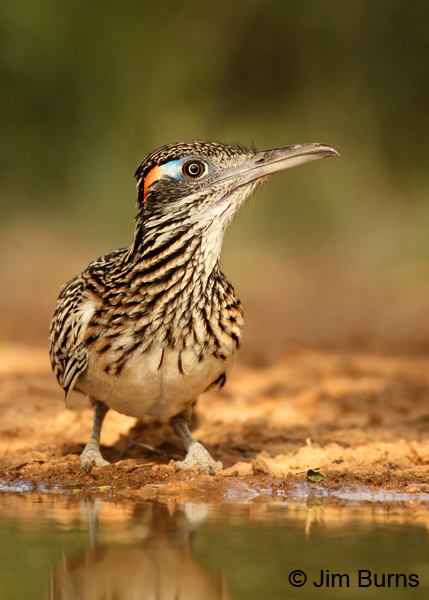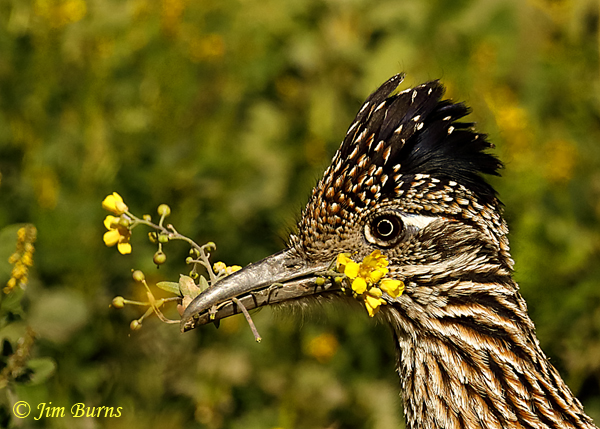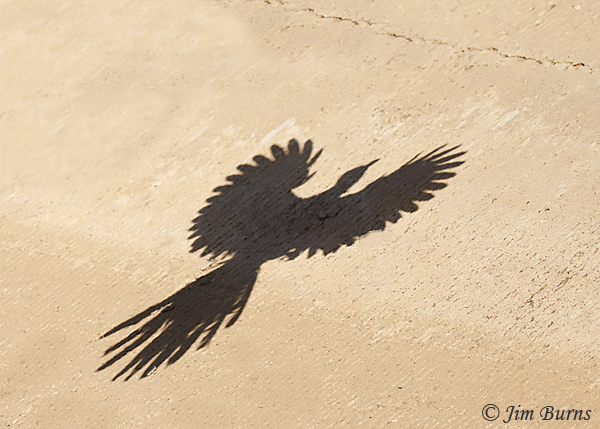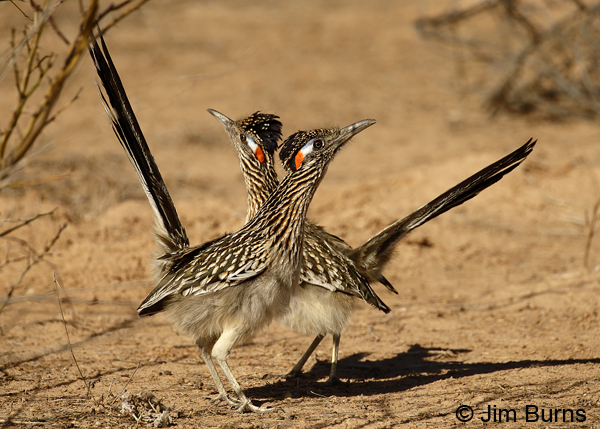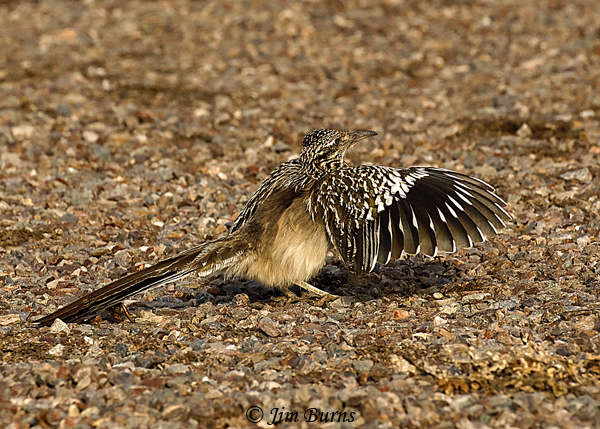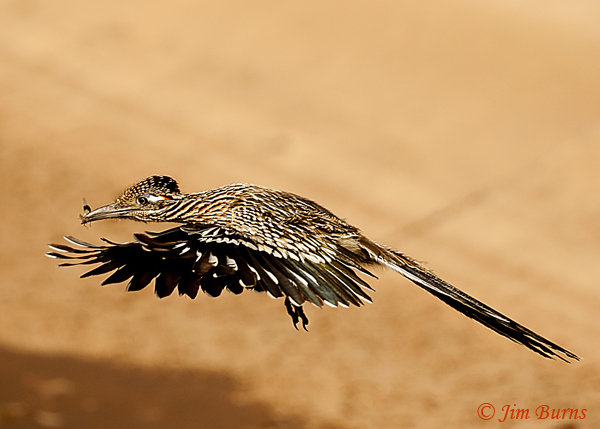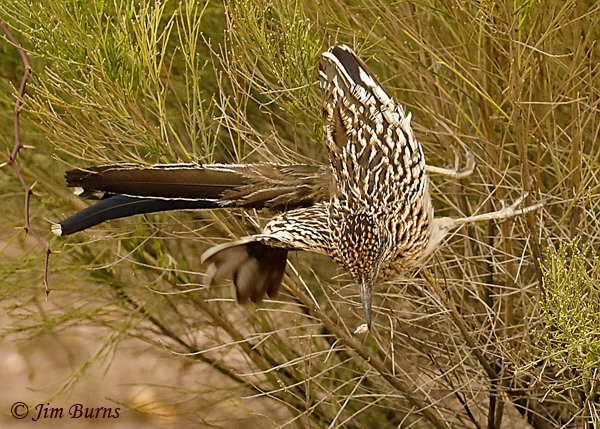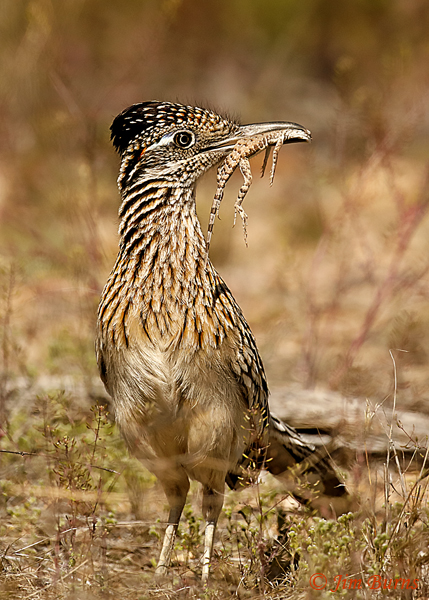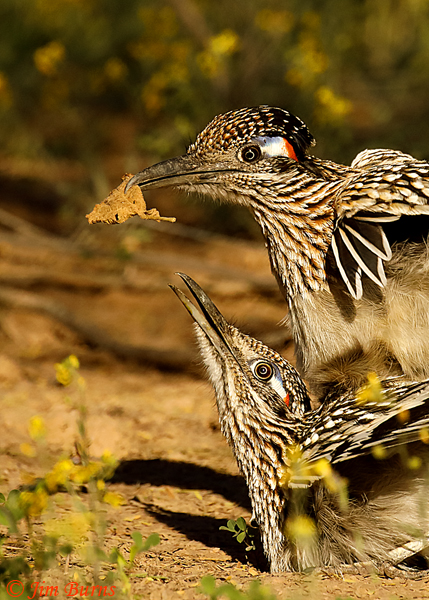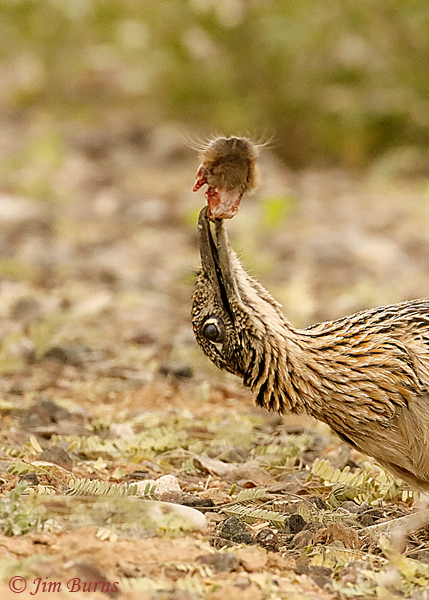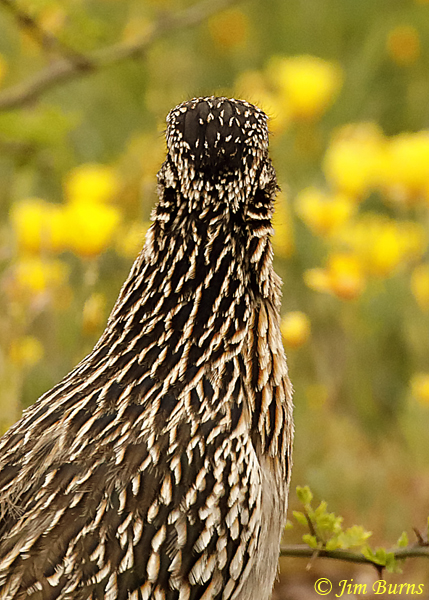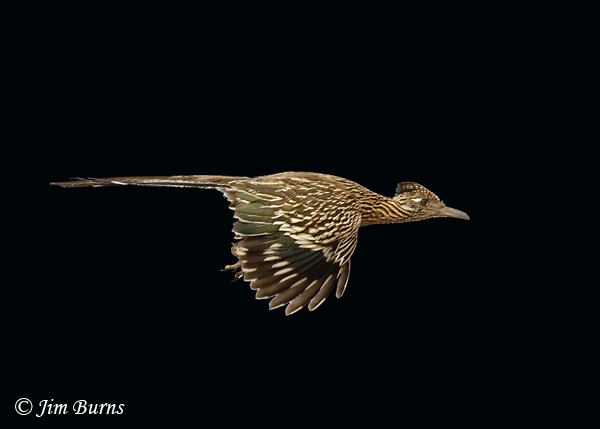This article and these photographs appeared in the February, 2020 issue of Birdwatching
Greater Roaderunner at waterhole
When I first realized the diversity of prey species my Greater Roadrunners were catching—lizards, butterflies and moths, bees. dragonflies, scorpions, grasshoppers, cockroaches, snails— and how they were catching them, I knew I had to write them up. Then when I saw him bring her a bunch of yellow wildflowers, Desert Bladderpod, as nesting material, I knew I had to write them up carefully to avoid rampant anthropomorphism.
Greater Roadrunner male carrying Desert Bladderpod for nesting material
Birders are well aware of the several avian families that capture prey on the wing, raptors, nightjars, and flycatchers most notably, but roadrunners are seldom seen “on the wing” so it is not well appreciated how aerially adept they are and how developed their beak-to-eye coordination is. All of those enumerated species that can fly, plus lizards and snails which obviously can’t, I have seen my pair of roadrunners catch while off the ground, airborne. Let me explain and highlight just how athletic these “ground” cuckoos really are.
Greater Roadrunners in the central Arizona area around Phoenix are not rare, but they are certainly uncommon. Good luck trying to find one to show a visiting birder from the east. They have large territories (up to a mile in length) and their heavily streaked, dark plumage can render them nearly impossible to spot unless they’re moving. I found a pair that I was able to follow, photograph, and study for two years only because one day in early spring I saw them on the move, chasing and catching grasshoppers.
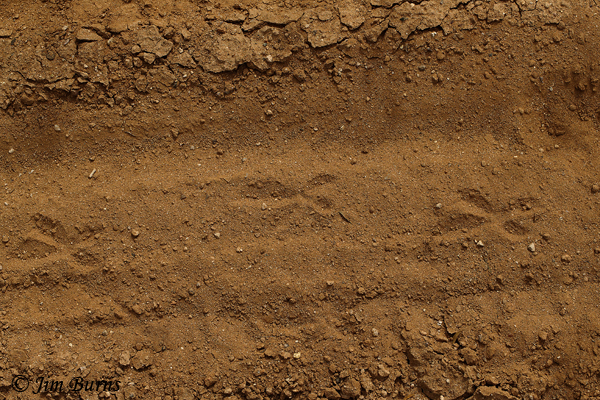
Greater Roadrunner tracks, X marks the trail
Greater Roadrunner flight silhouette
A recent research study, “Ecological winners and losers of extreme drought in California,” found that locally rare and less common species increase in periods of drought, and Greater Roadrunner was one of two avian “winners” in this study. When I discovered my pair in February on the Tonto National Forest abutting the northeast suburbs of metro Phoenix, the area had recently experienced over 100 consecutive days with no rainfall.
Previous roadrunners I had seen were shy, solitary, and seemingly on a mission, yet this pair was relatively at ease with my presence. Whether a result of that year’s drought or simply because the Tonto is the most heavily used “urban” forest in the country and they were acclimated to people would make another good research project. Whatever the case, they became my roadrunners for the next 24 months.
Greater Roadrunner pair
That day of our first encounter I couldn’t believe I was seeing two roadrunners foraging together. They were working along a stretch of desert gravel interspersed with acacia and mesquite trees and tall stands of wildflowers including Globemallow and Brittlebush. Sensing they were comfortable with my shadowing them if I moved slowly and kept a respectful distance, and knowing roadrunners mate for life and hunt together during courtship, I figured this might be a once-in-a-birder’s-lifetime chance to gain some insight into an iconic species’ natural history.
Greater Roadrunner female wing flashing for insects
My first surprise was learning a primary roadrunner foraging technique is wing-flashing, the very same method first made familiar to many birders by Northern Mockingbirds—walk several steps, stop, spread both wings, then repeat. If the white patches on the open wings flushed an insect, of course, they were all over it. Choosing to concentrate on just one of the pair, the female as it turned out, (more later on how I was able to distinguish male from female) I was dumbstruck when I saw her suddenly sprint ten yards, leap six feet into the air, and come down with a grasshopper on the wing that she had flushed. She had me when I realized she had jumped higher than my head and I hadn’t even seen the insect flush. I soon watched her mate leap over a Brittlebush, two feet high and three across, and snatch a grasshopper out of the air without touching the bush or its array of bright, yellow flowers.
Greater Roadrunner female snatching grasshopper in flight
The pair seemed to prefer open ground, but whenever either would come to a bush or a small tree with limbs hanging close to the ground it would completely circle the plant, staring intently upward. If prey items were spotted in the branches, a leap and grab with the bill was employed. Countless times over the months I saw both male and female crouch, jump several feet off the ground, snatch prey with the bill while pushing off a branch with their feet, fall toward the ground head first, then open their wings to slow the drop, and land on their feet. Don’t try this at home!
Greater Roadrunner rebounding from bush with snail
I came to call this the rebound technique because they never actually landed in a bush or tree when foraging like this. In the cool of the early mornings this technique yielded a wide assortment of prey items that had spent the night presumably safe and warmer above ground—spiders, caterpillars, both lepidoptera families (moths and butterflies), odonata (dragonflies), lizards, and snails.
Greater Roadrunner with Zebra-tailed Lizard
Roadrunner foot speed is legendary (upwards to 20 mph), but that is in linear pursuit. Not as well appreciated is the species’ ability to cut, turn, and change direction while chasing elusive prey such as rabbits, ground squirrels and, especially, lizards. Remembering how futile it was trying to catch lizards myself, as a kid, I watched their athleticism in awe as they pursued land based prey across the desert and through brush, dust and feathers flying. I saw them catch several lizards wishing I had video capability. I also saw them with mice, a juvenile rabbit, and a killdeer chick, though I did not witness those captures.
Greater Roadrunner tryst with gift of leaf
My best capture was a photo cliché I had envisioned for years--on four occasions I was in the right place at the right time with the camera to catch the pair copulating, all four times with a gift exchange, once dried vegetation for nesting, once a leaf, once a grasshopper, and once not one but two White-lined Sphinx Moths. Courtship and copulation were also displays of the species’ athleticism, the male chasing with gift while wagging his tail horizontally, the female, crest erect, tail bobbing vertically. If and when she was ready, she assumed submissive posture and he leapt three feet in the air and dropped down onto her to mount.
Greater Roadrunner copulation
It was during courtship and copulation, of course, that I was finally able to distinguish male from female with certainty. She was slightly smaller and buffier breasted than her mate though this was difficult to discern unless they were seen together. However, after realizing these physical dissimilarities, unexpected behavioral differences became more obvious as I followed them through their breeding cycle--nest building, food foraging, and raising young.
Though smaller, the female seemed to be the more efficient hunter: in wing flashing she extended her wings forward to their fullest extent, he only about halfway; in rebounding she jumped higher into the foliage than he, possibly because she was lighter in weight; in feeding the nestlings (3 the first year, 2 the next) the male always made the first several deliveries of the day and, overall, made twice as many as she; she was much more circumspect and careful than he when approaching the nest tree (Whitethorn Acacia) with food, and when leaving she would slip down, crouch and freeze for several minutes before continuing out to forage whereas he bounded down and left quickly.
My pair’s nest, an aggregation of sticks lined with grasses and leaves, was in a crotch in the heart of their acacia, six feet high. It appeared this nest had been used in years past, and the only ‘remodeling’ was done by the female with soft materials brought by her mate, spectacularly so on the occasions when I watched him dig up or clip off wildflowers for the purpose.
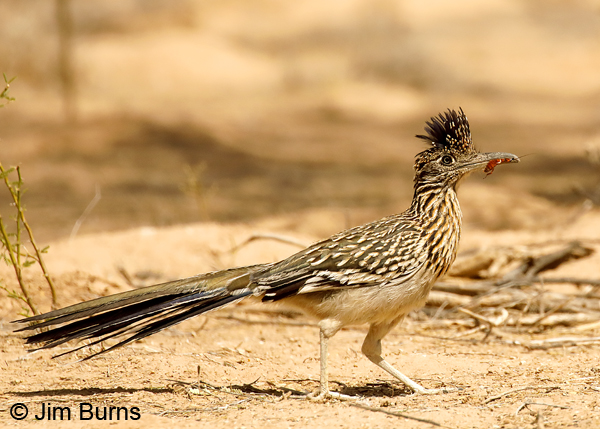
Greater Roadrunner male with Cockroach
Research has shown both parents incubate but only the male incubates and stays with young nestlings overnight in lower temperatures because he carries more fat deposits, thus his larger size. This became another useful clue in parental identification when I would arrive shortly after sunrise some mornings to catch one bird, the male, leaving the acacia as the female arrived. The timing of these duties (and her greater efficiency?) meant he delivered more insects, she more lizards which became more active only after the sun warmed the surrounding desert.
Eggs were never left alone but nestlings often were, especially as they grew and demanded more and larger food deliveries. Though the adults typically foraged together during courtship, after the eggs hatched they always went separate ways when leaving the nest, undoubtedly an evolutionary adaptation to insure the best coverage of the entire territory.
Greater Roadrunner disarticulating Botta’s Pocket Gopher
Here are five fascinating things I observed which are all well documented in Greater Roadrunner literature but casual birdwatchers seldom see: beating larger prey items against a rock to disarticulate the carcass for easier swallowing; closing the nictitating membrane in flight and while feeding young; adults sitting out the heat of mid-day in the shade despite nestlings unattended; actual copulation is very lengthy (up to 4 minutes); lethargic or unresponsive nestlings are fed to siblings.
Greater Roadrunner Waste Not, Want Not
Greater Roadrunner false eye spots
Here are five fascinating things I observed which I could not find referenced anywhere in the literature: carrying multiple prey items (five grasshoppers!) in the bill at once; the male teaching first fledged (largest) how to forage and hunt; always picking up and delivering lizards’ tails broken off in capture; false eyespots on the back of the head rather like some owl species; vocal signaling between mated pair much more frequent than the human ear can hear.
And five things I’d hoped to observe but didn’t: eggs in the nest (the nest was just above eye level and deep inside the thick, thorny tree—no way to see into); territorial defense; nest defense; snake capture; a roadrunner outrunning a coyote (not going to happen—former’s top speed 20 mph, latter’s 40 mph).
Greater Roadrunner prey exchange, White-lined Sphinx Moth, male on left
The second spring of my observations was during an
El Nino year in the Arizona deserts, and the roadrunners breeding cycle followed the wettest October in Phoenix history. They reused the same nest, but the surrounding habitat was vastly different, lush and green instead of sere and dusty. Wildflowers were profuse, waist high weeds and grasses carpeted the territory, and open desert was scarce.
I couldn’t help thinking if the previous spring had been like that, perhaps that brood’s third sibling would have survived. On the other hand, if the years’ weather had been reversed, it is unlikely I’d have seen the roadrunners in the first place or been able to follow them on their rounds, so effective their cryptic coloration, so hidden they became in the burgeoning desert vegetation.
These are active birds that look plump when feathers are fluffed out, and go up to two feet in length and a pound in weight, yet I saw one pass through a square opening in fence wire that I subsequently measured at three and a half inches in width, the length of my index finger! Like athletes of other species, roadrunners are lithe, remarkably flexible, and can shapeshift seemingly at will. They have evolved to breed among thorns, forage through brambles, and capture and consume anything and everything in their environment. And they thrive in drought conditions.
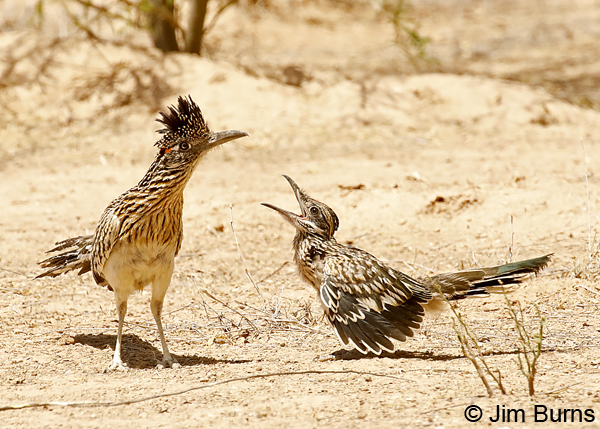
Greater Roadrunner fledgling begging
It is little wonder that Greater Roadrunner, revered by the ancients, has become the modern icon of the Southwestern deserts. Attentive in parenthood but brutal in predation, readily admired but difficult to find, easily anthropomorphized but largely misunderstood, my roadrunners have gifted me these past two years with great insights into the natural world around me and, in the process, to my place in it. Long may they prosper.
Roadrunner in flight
